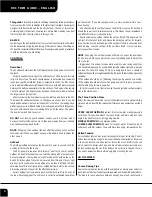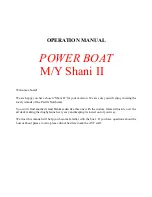
3.4
After your initial run:
• Check oil level in the engine
• Check the transmission oil level
• Check for leaks (water, fuel and oil)
• Engine frame bolts and mounts are tight
• Throttle and shift control operates correctly
WARNING: If the engine backfires when you try to start it, the problem
may be more serious than flooding. DO NOT CONTINUE TRYING
TO START THE ENGINE; CONTACT YOUR CORRECT CRAFT
DEALER OR A QUALIFIED TECHNICIAN TO CORRECT THE
PROBLEM. To keep on trying to start the engine under these conditions
could cause engine damage or physical harm to you and those
around you.
Break In Procedure
Make sure all your passengers are properly seated before starting the break in
procedure. After the engine is thoroughly warmed up and you have driven the
boat into a large open area, open the throttle to wide open until the maximum
RPM’s are reached. Do not exceed 5,000 RPM. Reduce the throttle to 2,800-
3,000 RPM’s and cruise at or below this speed for 1/2 hour. Reduce the speed
to idle, open the throttle wide and operate at that speed for one minute; reduce
to the previous cruising speed for a few minutes and repeat. Accelerating from
idle speed to full throttle loads the engine and assists in seating the piston
rings. This cycle can be repeated from time to time during the first five hours
of operation, but full throttle should not be used for longer than 1-2 minutes.
WARNING: Follow these procedures only when conditions are such that you
can drive the boat safely..
CAUTION Do not attempt to break in an engine by letting it idle at the
dock.
G
E N E R A L N O T E S
The maximum RPM of the engine at full throttle under normal load conditions
can be controlled by propeller pitch, diameter and design. It is essential that
the propeller does not underload or overload the engine.
Propeller Overloading
, resulting in low RPM’s at wide open throttle will
give poor performance, poor fuel economy and eventually result in engine
damage.
Propeller Underloading
, if operated with a propeller that has too little pitch
or diameter, poor performance will result.
NOTE: Running your boat in shallow water can cause sand and silt to be
pulled into the cooling system. This can create excessive water pump wear and
Sport Nautique 216 2003.qxd 7/29/02 11:23 AM Page 3.4
Summary of Contents for Sport Nautique 216
Page 4: ...iv...
Page 40: ...Notes...
Page 42: ......
Page 48: ...3 6...
Page 50: ...Inside Engine box on Fuel Tank Water Strainer Fuel Fill Throttle Control 4 2...
Page 51: ...Transom Warning Label Cross Member Boarding Platform Engine 4 3...
Page 52: ...Flame Arrestor Flight Clip Walk Thru Windshield Dash Pod 4 4...
Page 53: ...Fuel Control Cell 4 5...
Page 54: ...Side Console 4 6...
Page 55: ...Flight Control Tower 4 7...
Page 56: ...Capacity Plate 4 8...
Page 70: ...6 12...
Page 76: ...8 4...
Page 82: ...9 6...
















































